This easy breakfast hash recipe is sure to be a hit! Featuring sautéed leeks, crispy potatoes, and earthy mushrooms. Topped with poached eggs and a buttery homemade hollandaise sauce! Vegetarian.
We really leaned into the warm-and-cozy vibes with this leek and potato hash: It's tailor-made for a lazy Saturday morning when you want to putter around the kitchen a bit, but still have breakfast ready in under an hour.
There are several steps to this veggie hash recipe, so you'll need a few different pots and dishes, but we promise: It's totally worth the extra cleanup. (If you're looking for more of a one-pot breakfast wonder, try our Italian Baked Eggs or Chorizo Baked Eggs!)
We're building three main components here:
- The Hash! Leeks, mushrooms, and diced potatoes form the base of this dish. Use a thick, sturdy pan to make the hash (we recommend a cast iron skillet).
- Poached Eggs. A perfectly poached egg makes this hash feel extra special (and you just can't beat those creamy, yolky, pure gold centers!)
- Hollandaise Sauce. This buttery sauce is famous as a topping for eggs Benedict, but it's excellent on breakfast hash as well. Use an immersion blender to make our creamy homemade hollandaise sauce in under 5 minutes!
Jump to:
Ingredients You'll Need

You'll find a detailed list of ingredients and exact quantities in the recipe card below. But before you jump in, we want to share a few notes to help you along:
For the Hash
- We used one large russet potato in this recipe, but you can use whatever you have! Russet potatoes and red potatoes are our favorite varieties for hash because they hold their shape well, but you can also use Yukon Gold or yellow potatoes.
- Dice your potato into small, evenly sized cubes (about ½-inch on each side). If you use bigger potato pieces, they'll need extra time to cook.
- Poach as many eggs as you like! As written, this leek hash recipe makes enough for 2-3 servings; we usually serve it with 1-2 poached eggs per person. Stretch it out by adding extra eggs and a side of toasted homemade bread (if you're cooking for two, you can also give our small batch crusty bread a try!)
For the Hollandaise Sauce
- Egg yolks form the base of our hollandaise sauce. Use high quality eggs that are fresh from the store (Learn more: How to tell if eggs are fresh). Save the egg whites for scrambled eggs or omelettes later in the week (or use them in our Small Batch Chocolate Chip Cookies!)
- Lemon juice and salt add flavor and depth to our hollandaise.
- Hot, melted butter brings the sauce together and adds flavor and richness. Your butter should be quite hot to ensure the hollandaise reaches a safe temperature: We typically melt our butter in a small skillet or saucepan on the stovetop, and pull it off once it reaches a very low simmer.
- A splash of warm water helps thin out the hollandaise sauce so it's perfect for drizzling!
Riffs and Substitutions
There are so many ways to customize a simple potato hash with eggs. A few of our favorite ways to riff on this recipe:
- Swap the potato for a sweet potato!
- Add extra veggies. Butternut squash, brussels sprouts, fresh spinach, and chopped kale are all great in this breakfast hash. If you add a heartier veggie (like diced butternut squash) you may need to extend the cook time.
- Mix up the eggs. We used poached eggs in these photos (we love a good runny yolk!) but this hash is great with any style of eggs: Try it with fried or over easy eggs, or add scrambled eggs instead.
How to Prepare Leeks

Trim and Slice the Leeks
To prepare the leeks for this recipe, trim the dark green pieces off the top and cut the root off the bottom.
Slice the remaining leek (the white and lightest green pieces) in half lengthwise, then place the flat side down on your cutting board and slice. See it in more detail: How to Cut Leeks.
Cleaning Leeks
Leeks grow in sandy soil: Wash them thoroughly to remove any grit between their layers. Place sliced leeks in a big bowl of cold water, give them a vigorous stir to shake any sand and dirt loose, then use your hands or a slotted spoon to lift the leeks out of the water so the dirt stays at the bottom of the bowl. Let leeks dry on a clean tea towel until you're ready to use them.
Why do we remove the dark green part of the leeks? The dark green pieces of a leek are edible, but can be tough and bitter. In this recipe, we prefer to use the lightest portion of the leek - the white and very light green pieces - because they produce a smooth, buttery texture and rich flavor even though we're cooking them fairly quickly. Don't throw away the dark green leek pieces, though: Save them for vegetable or parmesan broth, add them to turkey stock or parmesan stock, or toss them into our favorite potato leek soup.
How to Make This Breakfast Hash
When your ingredients are prepped, it's time to build the hash!
First, Cook the Potatoes

Heat a drizzle of oil in your cast iron skillet, then add diced potatoes to the hot pan and spread them out into an even layer. Stir the potatoes once every few minutes, letting them settle and cook in between each stir, until they've developed a golden brown color and are nearly cooked through.
Pro Tip: If the potatoes are sticking to the pan, it's because (1) the pan wasn't hot enough and/or (2) the potatoes need more time to cook! Once the surface is nice and crispy, the potatoes will lift right off a properly preheated stainless steel or cast iron pan. Crisping potatoes in a pan can take some practice - don't worry if they don't look perfect on the first try!

When your potatoes are browned, remove them from the skillet and set them aside (we'll add them back to the hash later!)
Cook the veggies

Add another drizzle of oil to your skillet and return it to the stove over medium-high heat. Add your mushrooms (Image 1, above) and cook for a few minutes until they've softened and lightly browned, then add the sliced leeks (Image 2) and cook for another couple of minutes until soft (Image 3).

When the mushrooms and leeks are cooked, return the cooked potatoes to the skillet and stir everything together (Image 4). Turn the heat down to its lowest setting and let the hash hang out, stirring it occasionally, for another 5-10 minutes while you prep the hollandaise sauce and poach the eggs!
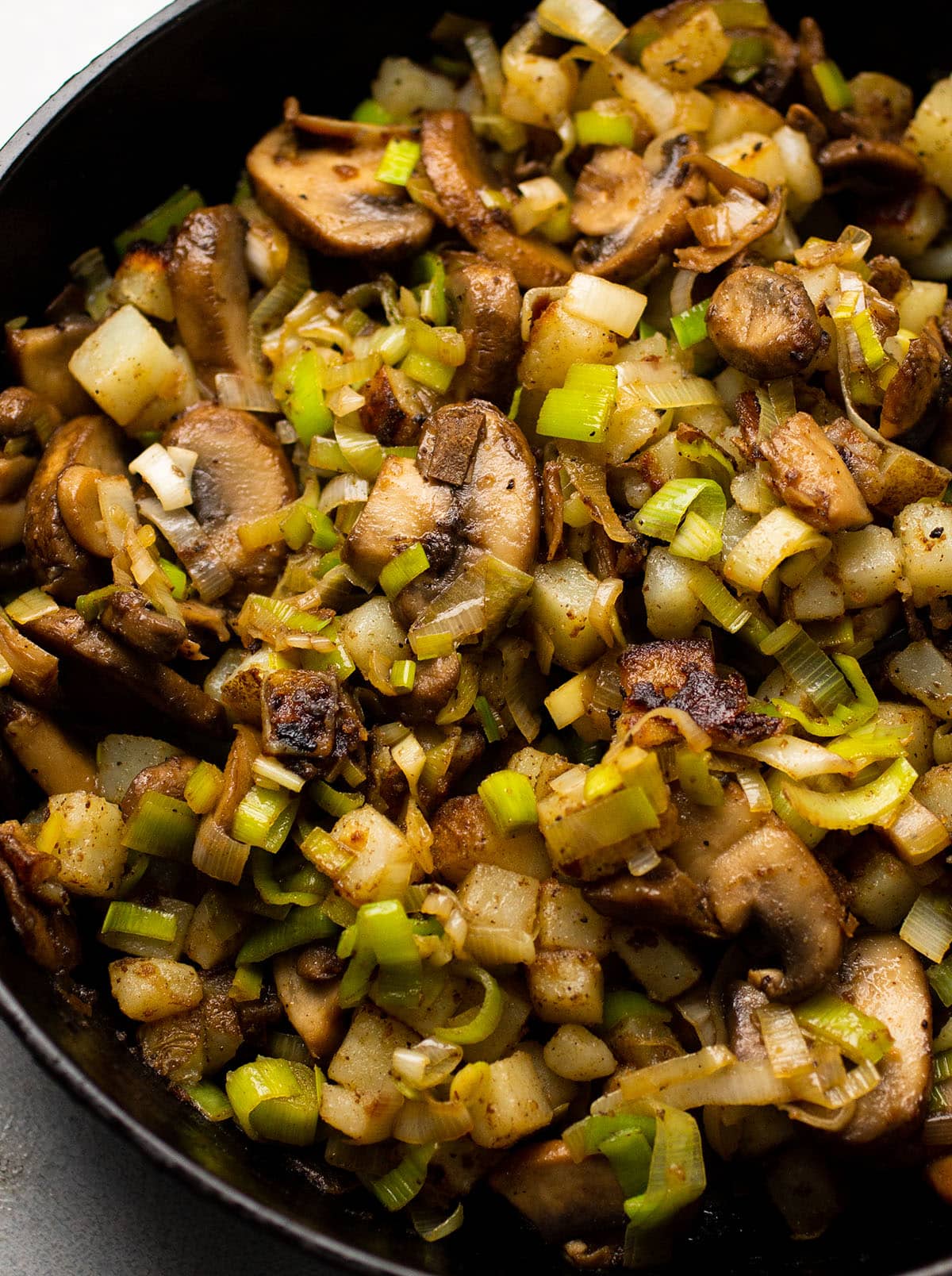
Top with Hollandaise Sauce
When your hash is ready, it's time to make the hollandaise! We're using our favorite immersion blender hollandaise here. In a nutshell:
- Add egg yolks to a tall, narrow jar (we used the plastic beaker that came with our immersion blender!) with lemon juice, a splash of slightly warm water (straight from the tap is fine!), and a pinch of salt.
- Use your immersion blender to blend the egg yolks for at least 30 seconds. The goal here is to work some air into the yolks and to let the whizzing immersion blender blades heat the mixture up a bit. Be sure to move the immersion blender around so it has a chance to "grab" onto all of the ingredients!

- Once blended, the egg yolks should yield a thin mixture with some visible air bubbles across the surface.
- With the immersion blender running, SLOWLY stream your hot butter into the beaker. Add just a teaspoon or two of butter at a time here - if you add it too quickly, your eggs can scramble and your hollandaise won't thicken.
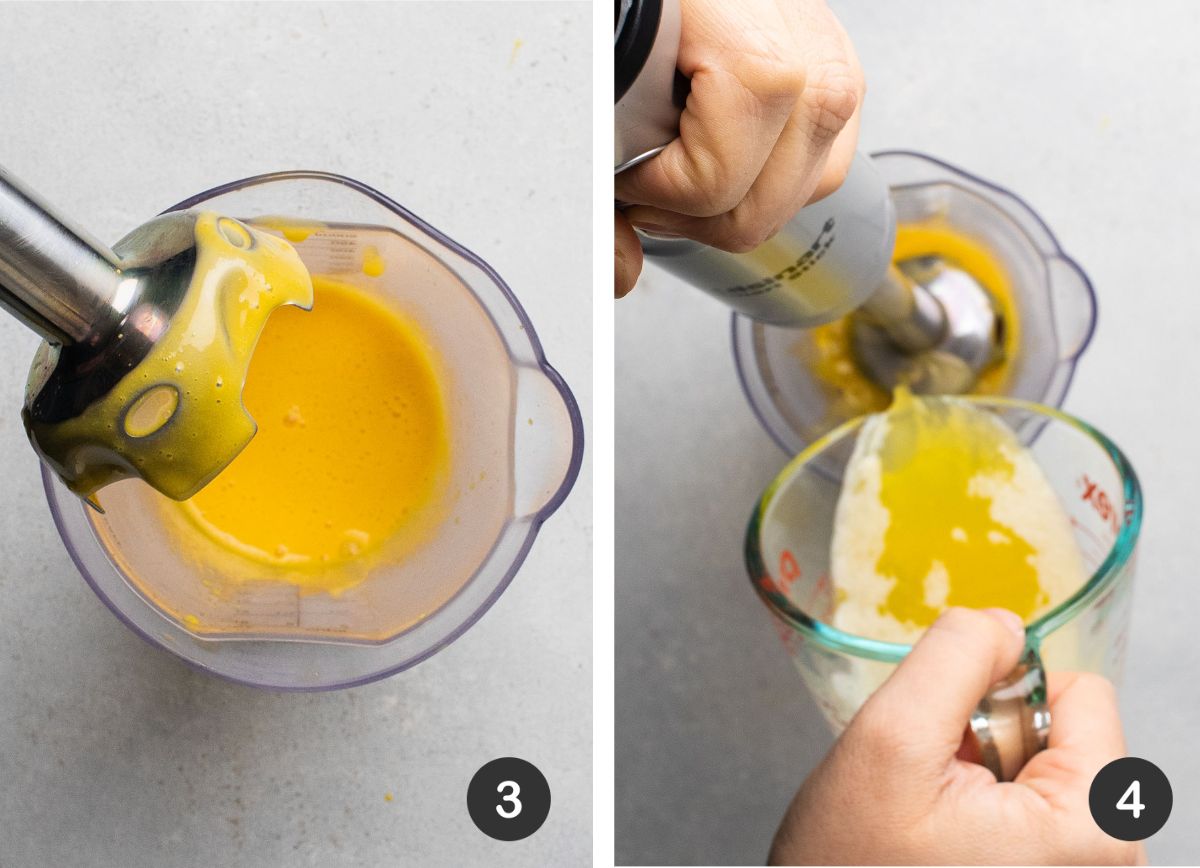
When all the butter has been blended into the hollandaise, you should have a fairly thick, creamy mixture. Be sure to move the immersion blender up and down as you blend to ensure the blades pull all of the butter into the sauce.
If the hollandaise is still too thick, add another splash of warm water and blend until it reaches a drizzle-able consistency.
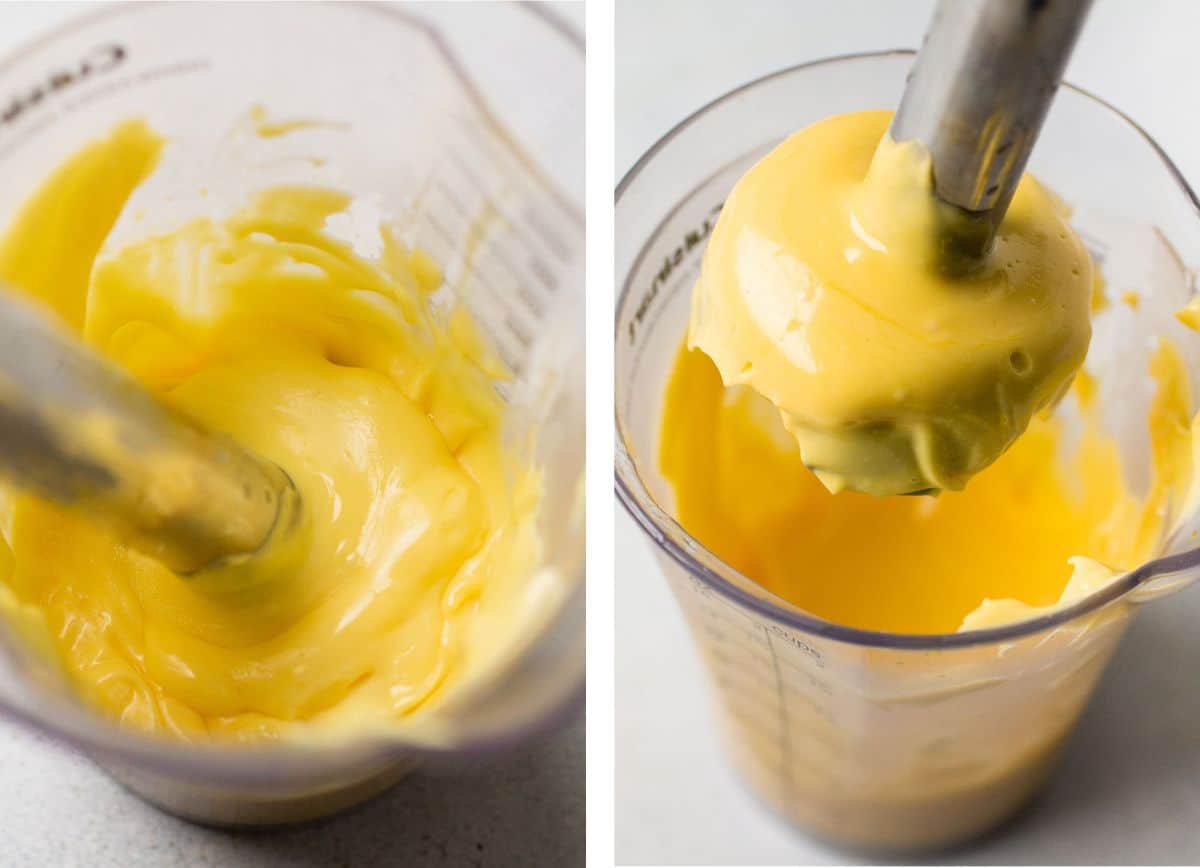
Hollandaise and Food Safety
Hollandaise sauce relies on raw egg yolks for its color and texture. Because raw or undercooked eggs always carry a risk of food borne illnesses, it's important to pay close attention to temperature whenever you make hollandaise at home. (Learn More: Eggs and Food Safety).
Make sure you are using hot butter (between 180° and 200° F) to ensure the hollandaise reaches a final temperature of at least 140° Fahrenheit. 145° F is an ideal temperature for hollandaise: If it's below 140° F, it's in what the USDA refers to as the "danger zone", where bad bacteria can thrive; past 150° F, the eggs may start to curdle. Once mixed, hollandaise should be used immediately.
Don't want to use raw eggs? No worries! This hash is great on its own. You can also try a vegan hollandaise sauce recipe, or replace the hollandaise with a quick Greek yogurt and lime juice drizzle (like we use in our Chorizo hash).
For more on hollandaise, see our full Immersion Blender Hollandaise tutorial!
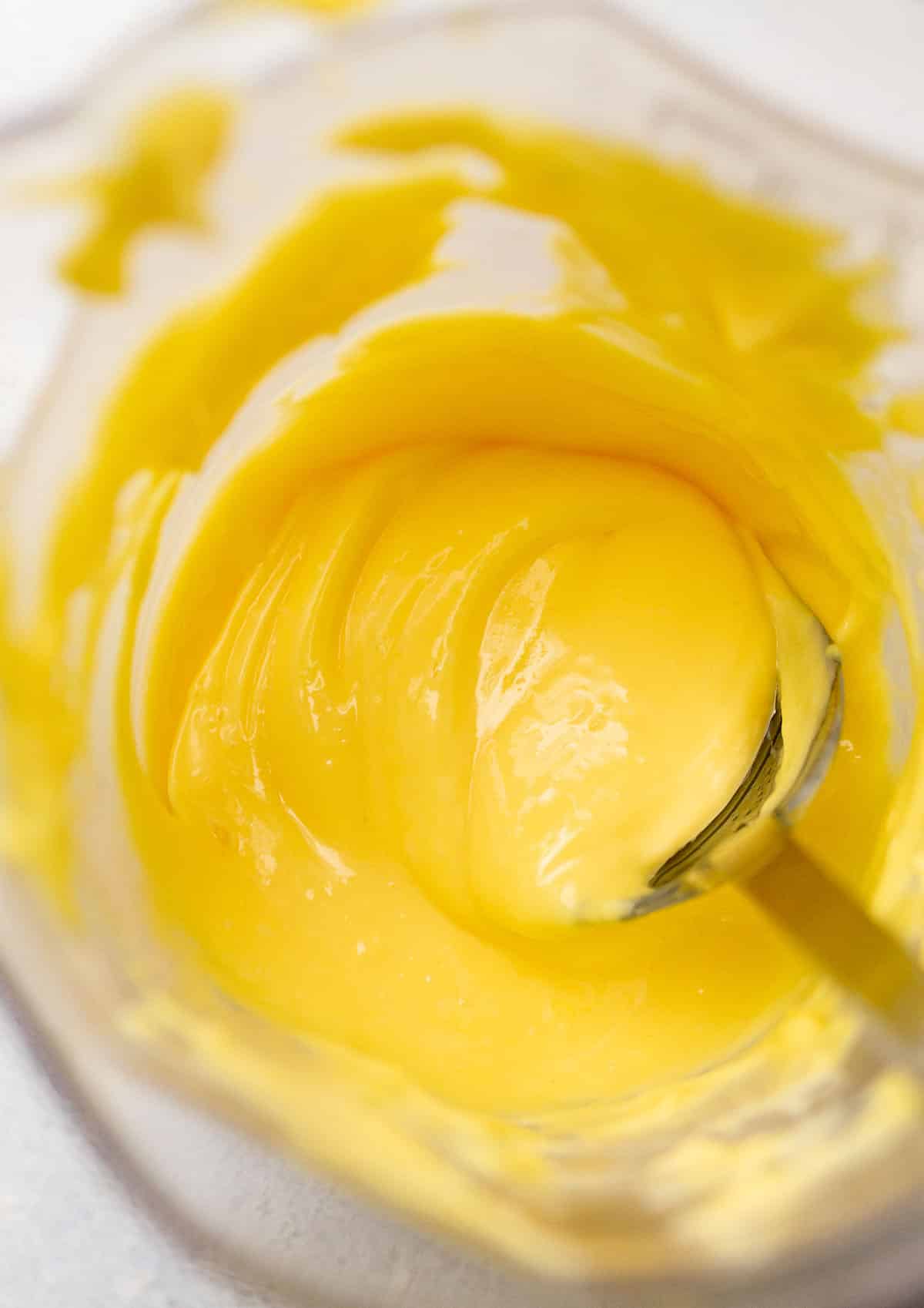
Three Rules for Excellent Breakfast Hash
- Use a thick, sturdy skillet. A great skillet breakfast hash starts with a great skillet! We recommend a large cast iron skillet or high-quality stainless steel skillet (at least 12" in diameter) here.
- Pre-heat your skillet properly. Place the skillet over medium-high heat and let it preheat for a few minutes so the surface is nice and hot. A hot pan helps prevent food from sticking and helps develop a nice crust on our diced potatoes. Learn more: How to heat pans before cooking.
- Don't touch the potatoes too much while they cook. Let them sit in the hot pan for a few minutes without stirring to help them develop a nice, crispy crust! If your potatoes start to burn, give them a stir and turn the heat down a bit.

A Few FAQs
Yes! Let leftover hash cool completely, then store in an airtight container in the fridge for up to 3 days. Reheat hash in a skillet over medium-high heat and serve it as is or use it as a filling for some tasty breakfast tacos! We do not recommend saving leftover eggs or hollandaise sauce.
To prevent sticking, first make sure your pan is nice and hot! Also, try to move the potatoes as little as possible: Let them sit in one place for a few minutes, and once they develop a nice crust, they'll pop right off the surface of the hot pan! This can take some practice. If you end up with burnt-on potato pieces (it happens!) don't worry - they're easy to clean. Read more: How to clean burnt food off stainless steel cookware.
We recommend using a large (at least 12") cast iron skillet or stainless steel pan when making hash. Be sure to preheat your pan for best results (learn more: How to heat pans before cooking). You can use a nonstick skillet if you prefer, but you'll get a better sear on your potatoes with cast iron or stainless steel.
The step of frying the potatoes is really more about developing flavor than anything - they'll soften up as the hash comes together, but the flavor will remain. They won't be as crispy as hash browns or french fries, but they'll taste great!
Yes! Because it's such a small quantity, we find this hollandaise works best in smaller blenders that have the blades at the bottom (as opposed to a blender that has blades running all the way up and down a tall center piece). Make sure your blender has a top cap that can be removed to allow you to stream the butter in. This recipe does not work with bullet-style blenders.
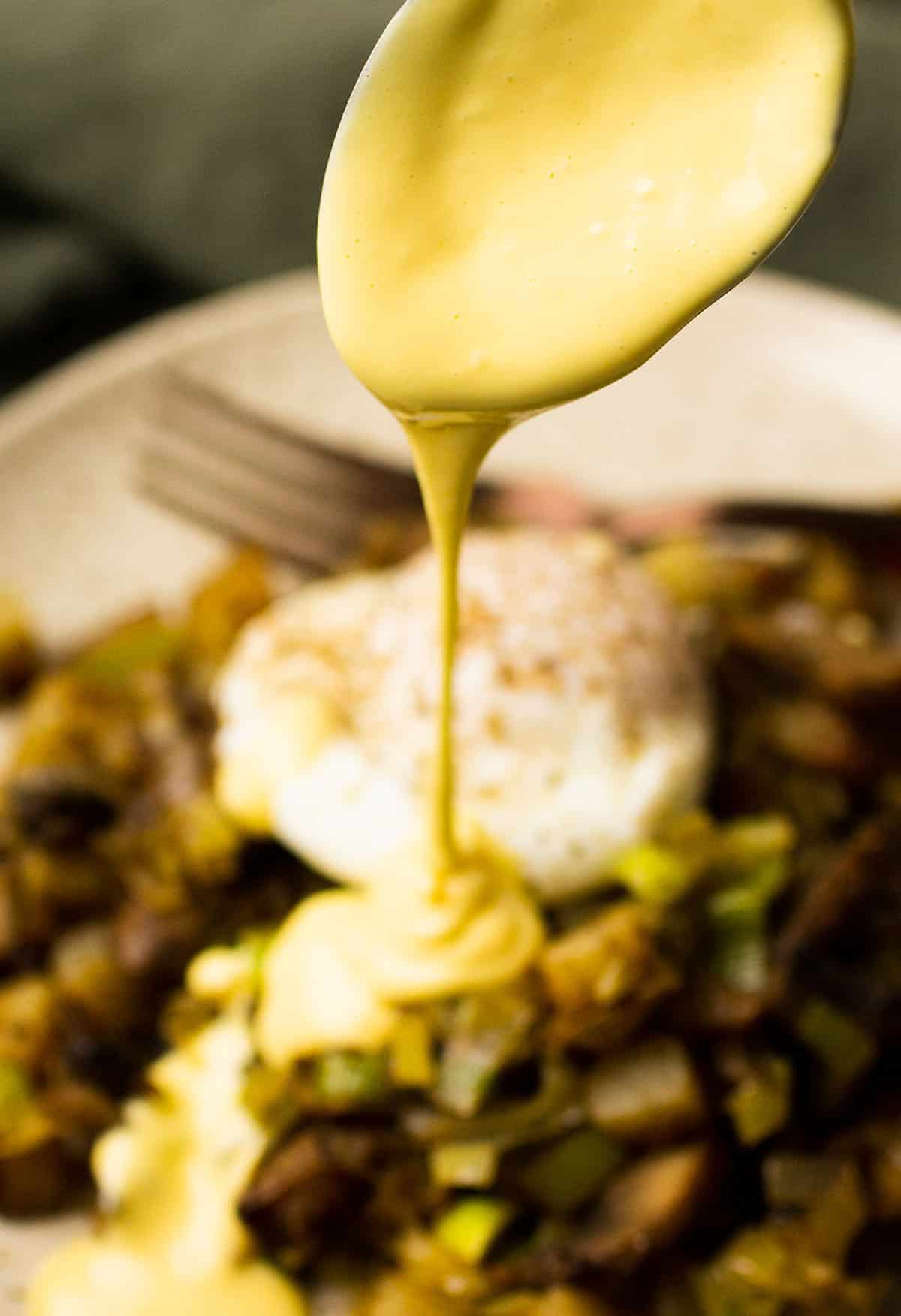
More Cozy Breakfast Ideas
Did you make this recipe? Leave a comment and star rating below to let us know how it turned out!
Print📖 Recipe

Vegetarian Leek and Mushroom Hash
- Prep Time: 15 minutes
- Cook Time: 35 minutes
- Total Time: 50 minutes
- Yield: Serves 2-3 1x
- Category: Breakfast
- Cuisine: American
- Diet: Vegetarian
Description
This cozy mushroom, potato, and leek breakfast hash is topped with a buttery homemade hollandaise and poached eggs. Vegetarian.
Ingredients
For the Hash:
- 3 Tablespoons olive oil, divided
- 2 leeks (white and light green parts only), sliced and cleaned (about 2 cups)
- 10 ounces baby portobello mushrooms, sliced (about 2 cups)
- 1 large russet potato, diced into small cubes (about 2 cups)
- kosher salt and pepper to taste
For the Poached Eggs:
- 1 Tablespoon white vinegar
- 2-4 eggs
For the Hollandaise:
- 2 egg yolks
- 2 Tablespoons warm water (we use tap water that's slightly warm to the touch - about 90° F)
- 1 Tablespoon lemon juice
- ¼ teaspoon kosher salt
- ½ cup (1 stick) unsalted butter
Instructions
Prep (15 minutes)
- Fill a small saucepan with water and bring it to a low simmer over medium heat. You'll use this water to poach your eggs!
- Gather any other equipment you'll need, including a large cast iron skillet (for the hash), a small saucepan (to melt your butter), and an immersion blender with a tall jar or beaker (for the hollandaise).
- Wash, chop, and measure all of your ingredients. The recipe will come together much more quickly and easily if everything is prepped and ready to go!
Make the Hash (25 minutes)
- Heat a large cast iron skillet (we recommend ~12" diameter) over medium-high heat. When the pan is hot, add 2 Tablespoons of olive oil and let it heat up for a few seconds (a very hot pan is the key to crispy potatoes that don't stick!)
- Add potatoes and cook for 10-15 minutes, stirring only occasionally, until potatoes are browned and nearly cooked through. Stir in salt and pepper.
- Remove cooked potatoes to a separate bowl, then return the pan to the stove over medium-high heat.
- Add remaining olive oil to pan and let it heat up for a few moments, then add mushrooms. Cook for 3-5 minutes, stirring occasionally, until mushrooms have softened and lightly browned.
- Add leeks and cook another 2-3 minutes, stirring occasionally, until leeks are soft and lightly browned.
- Return cooked potatoes to the skillet. Add salt and pepper to taste, then stir to combine. Turn the heat to its lowest setting and let the hash hang out, stirring it occasionally, while you make the hollandaise.
Make the Hollandaise (5 minutes)
- Melt butter in a small saucepan until it bubbles (butter should be about 200° F: bubbling, but not browning). Transfer melted butter to a small measuring cup with a spout to make it easy to pour into the hollandaise.
- Add egg yolks, lemon juice, warm water, and salt to a tall, narrow cup that fits the head of an immersion blender. Blend for about 30 seconds until you have a smooth mixture that's slightly lightened in color.
- With the immersion blender running, add hot butter to egg mixture a tiny bit at a time. Blend for a few seconds in between each addition to fully incorporate the butter and let the eggs heat up slowly (if you add the hot butter too fast, the eggs can curdle). Continue adding butter a little at a time, blending well between each addition, until all butter has been incorporated and the hollandaise is thick and fluffy.
- If your hollandaise is too thick, blend in additional warm water a teaspoon at a time until it reaches a drizzle-able consistency. Use an instant-read thermometer to check the temperature: Hollandaise should reach a minimum of 145° F for food safety. If your hollandaise is too cool, transfer it to the same skillet you used to melt your butter, and cook on very low heat - stirring frequently - until it reaches a safe temperature. Tip: Poach your eggs and make any toast or extra side dishes while the hollandaise is warming up!
Poach the Eggs (5 minutes)
- Add a splash of white vinegar to a pot of barely-simmering water (the vinegar helps the egg whites hold their shape better).
- Crack one egg into a small bowl or ramekin (this makes it easier to tip the egg into the water). Use a slotted spoon to stir the pot of water in a circle to form a bit of a whirlpool inside the pot, then tip the egg into the swirling water. Repeat with remaining eggs. (Depending on the size of your pan, you may need to work in batches here.)
- Cook eggs until the whites are set and the yolks reach your desired level of doneness (we recommend 3-4 minutes for a runny yolk). Tip: Plate the hash while your eggs cook to make assembly go quickly!
- Use a slotted spoon to remove poached eggs from the water and place them on top of your hash. Top eggs with a pinch of salt, then drizzle with hollandaise and serve immediately.
Notes
How to poach eggs: We included some quick, streamlined directions for poaching eggs in the recipe above. Poaching eggs can take some practice! If you're new to this method, we recommend checking out this guide: How to Poach an Egg Perfectly.
Additions and Substitutions. Swap the russet potato for red potatoes, yukon golds/yellow potatoes, or a sweet potato. Add extra veggies (onions, garlic, shaved brussels sprouts, bell peppers, spinach, kale) when you sauté the mushrooms and leeks. Use any style of eggs you like (fried, scrambled, and over easy eggs are all good here).
Hollandaise notes. Temperature is very important for homemade hollandaise! Be sure to heat your butter until it is quite hot (about 200° F) in order to bring the eggs to a safe temperature. Use fresh-from-the-store egg yolks. We recommend melting your butter on the stovetop; it's difficult to get it to the correct temperature in a microwave without spattering butter everywhere. No immersion blender? Use a small blender with a cap at the top that will allow you to add the butter while the appliance runs, and make sure the blades are at the bottom of the blender (this doesn't work very well if you blades running up and down the entire center core of the blender). Once blended, hollandaise should be used immediately. Use an instant-read thermometer to check the temperature once hollandaise is blended: Hollandaise should reach a minimum of 145° F for food safety. If your hollandaise is too cool, transfer it to the same skillet you used to melt your butter, and cook on very low heat - stirring frequently - until it reaches a safe temperature. Tip: Poach your eggs and make any toast or extra side dishes while the hollandaise is warming up!
Serving Sizes. This hash makes 2-3 generous portions. If you're serving more people, add extra veggies or poach more eggs to stretch it further or use the 1x/2x/3x buttons above to scale the recipe up. This recipe makes about 1 cup of hollandaise.
Crispy potatoes can take practice! For best results, use a cast iron skillet or a thick, high-quality stainless steel skillet, and give the pan time to preheat before adding the oil and potatoes. A hot pan prevents ingredients from sticking, and helps develop a crispy browned crust on your potatoes. Learn More: How to preheat a pan.
Nutrition
- Serving Size: 1 serving
- Calories: 679
- Sugar: 5.2 g
- Sodium: 645.2 mg
- Fat: 54.4 g
- Carbohydrates: 35.9 g
- Protein: 16.4 g
- Cholesterol: 452.3 mg
Keywords: breakfast, brunch, eggs


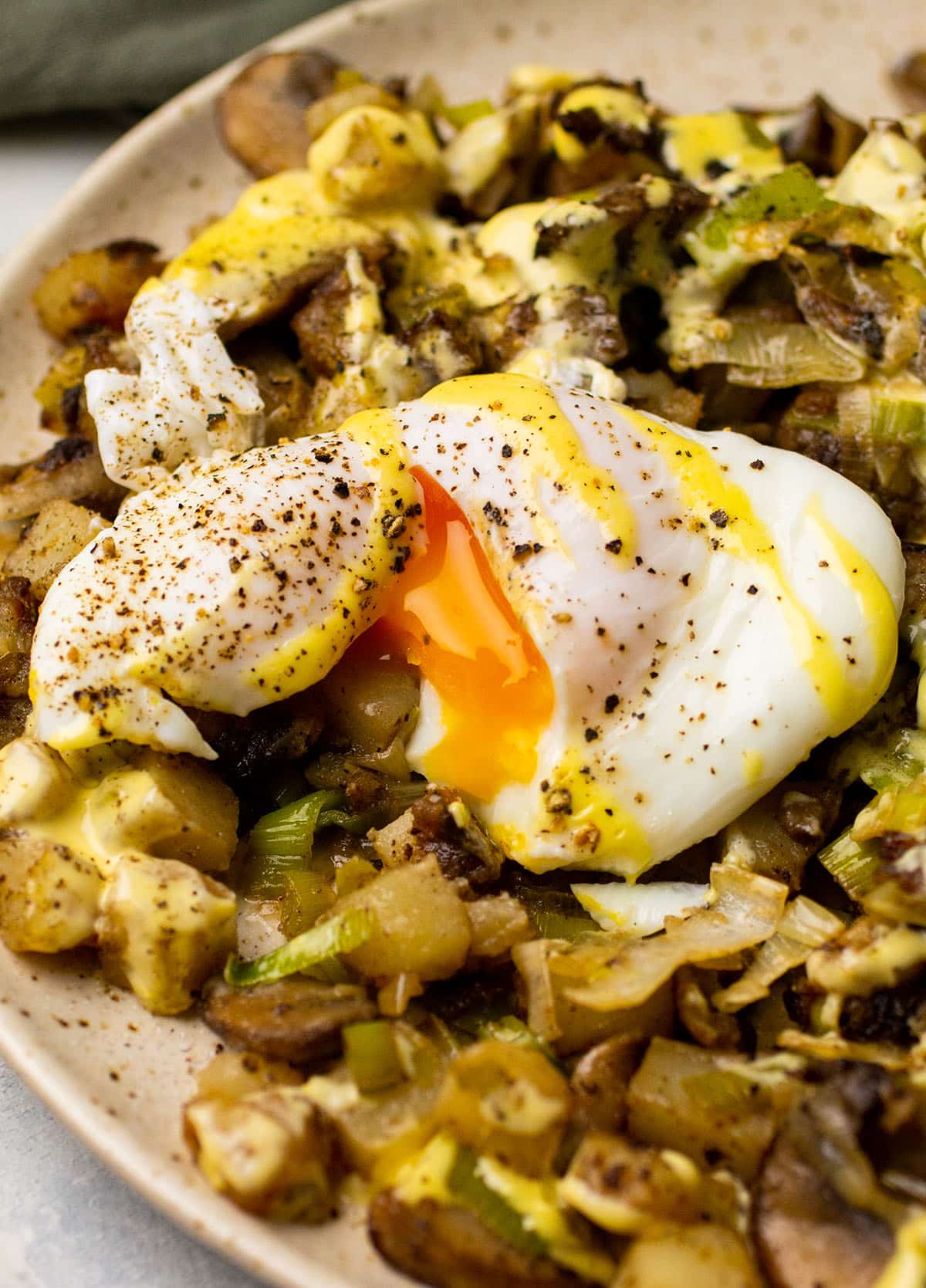


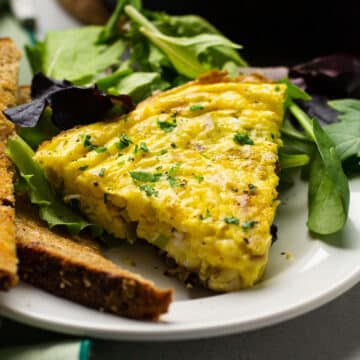



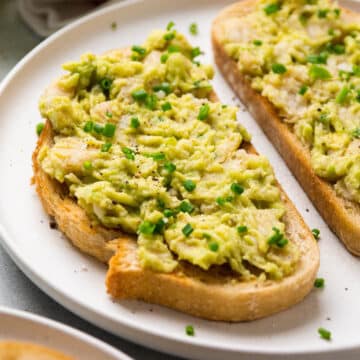



Meg
Your pics of the poached eggs "creamy, yolky, PURE GOLD centers" sold me. I was craving breakfast for dinner the other night and and just had to make this. It. Hit. The. Spot.
So delicious and everything came together quickly! Thanks for a great recipe!
★★★★★